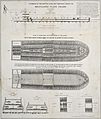Slave ship facts for kids

Slave ships were large cargo ships specially converted for the purpose of taking people captured for use as slaves, especially newly captured African enslaved people to the Americas.
Living conditions for these people on these ships was inhuman. Men, women and children were crowded into every possible space leaving no room to move or even breathe. There was little food and the smell could not be described. Between 1526 and 1867 about 12.5 million enslaved people were sent by slave ships from Africa to the Americas. But only about 10.7 million slaves actually arrived. Of all human migrations it was the most costly in terms of human lives lost. The average time to sail across the Atlantic took from 60 to 90 days. Sometimes the trips took up to four months.
Saleable enslaved people
Ship captains were under orders by slavers to deliver only saleable slaves. Starving, sick or troublesome enslaved people were often thrown overboard into the ocean to drown. Sometimes African people were kept on deck chained together with long chains. There were times when they would jump overboard, taking every other chained slave with them, to avoid their unknown fate. Many ships kept extra crew members on deck to prevent this from happening. At other times crew members would throw the enslaved people overboard as a warning to others. If the ship was running out of food or water, all the enslaved people would be killed to save the crew from starving.
Zong massacre
Slave ships could at times get insurance on their cargos of enslaved people. But insurance would not pay if the slavers starved the people or they got sick. Insurance paid out if the people drowned, but not if they were severely starved to death.
In 1781 the slave ship Zong was hauling 470 enslaved people — more than the ship could handle. Many began to get sick. By the time the ship reached the Doldrums, a mid-Atlantic region that at times had no wind, several of the crew had died from the spreading diseases. To save themselves, the remaining crew threw 132 dying and sick people into the ocean. Another 10 people jumped with them. When they tried to collect the insurance the Insurance underwriter denied the claim. In 1872 in a court in Jamaica, ruled for the owners. The insurance company appealed the decision. This brought a good deal of public attention. It began to be called the Zong massacre. No member of the crew or the owners were ever charged with murder.
Slave ship takeovers
About 15% to 20% of the ships leaving Africa never arrived in the Americas. In thousands of cases the crews were overtaken by the captured people, some of them warriors. Often the crew was killed and the Africans managed to sail back to Africa. In other cases the ships were lost at sea.
Some of the documented slave ship revolts are:
- The Little George ship revolt happened after the ship Little George left Guinea in June of 1730. It was carrying 96 enslaved people to Rhode Island. Several of the African men slipped out of their shackles and overpowered the crew. They killed three of the crew who were on deck at the time. The rest were taken prisoner. The Africans sailed the ship back to the Sierra Leone River where they abandoned the ship and still imprisoned crew.
- In 1732 a ship out of Portsmouth, New Hampshire captained by John Major had just loaded hundreds of enslaved people and was leaving when about 50 Africans took over the ship. The crew was killed with guns, axes, swords and other weapons taken from the crew members.
- In 1747 an American ship with a captain named Beers was taken over by hundreds of captive Africans in West Africa. All but two of the crew were killed with their own weapons. There was no record of how many Africans died during the short battle.
Images for kids
-
A plan of the British slave ship Brookes, showing how 454 slaves were accommodated on board after the Slave Trade Act 1788. This same ship had reportedly carried as many as 609 slaves and was 267 tons burden, making 2.3 slaves per ton. Published by the Society for Effecting the Abolition of the Slave Trade
See also
 In Spanish: Barco negrero para niños
In Spanish: Barco negrero para niños



